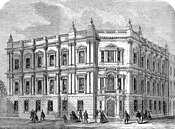This article has multiple issues. Please help improve it or discuss these issues on the talk page. (Learn how and when to remove these messages)
|

The Thames Embankment is a work of 19th-century civil engineering that reclaimed marshy land next to the River Thames in central London. It consists of the Victoria Embankment and Chelsea Embankment.
History
There had been a long history of failed proposals to embank the Thames in central London. Embankments along the Thames were first proposed by Christopher Wren in the 1660s, then in 1824 former soldier and aide to George IV, Sir Frederick Trench suggested an embankment known as 'Trench's Terrace' from Blackfriars to Charing Cross. Trench brought a bill to Parliament which was blocked by river interests.
In the 1830s, the painter John Martin promoted a version, as realised later, to contain an intercepting sewer. In January 1842 the City Corporation backed a plan designed by James Walker but which was dropped due to government infighting. The government itself built the Chelsea Embankment in 1854 from Chelsea Hospital to Millbank.

Started in 1862, the Victoria Embankment starting from Millbank on the main, north (or "left" bank) was primarily designed by Sir Joseph Bazalgette with architectural work on the embankment wall and river stairs by Charles Henry Driver. It incorporates the main low level interceptor sewer from the then limits of west London's growth, and an underground railway over which a wide road and riverside walkway were built and run today, shored up by the sturdy retaining wall along the tidal River Thames (the Tideway). In total, Bazalgette's scheme reclaimed 22 acres (0.089 km) of land from the river. It prevented flooding, such as around what had been the remnants of Thorney Island, much of which was owned by the Duke of Westminster. Those waterfront hotels, supply warehouses and genteel "town houses" which had boat access by inlets and watergates lost this.

Much of the granite used in the projects was brought from Lamorna Cove in Cornwall. The quarried stone was shaped into blocks on site before being loaded on to barges and transported up the English Channel into the Thames.
From Battersea Bridge in the west, it includes Cheyne Walk, Chelsea Embankment, Grosvenor Road, Millbank and Victoria Tower Gardens.
Beyond the Houses of Parliament, it is named Victoria Embankment as it stretches to Blackfriars Bridge; this stretch incorporates part of the shared District/Circle Line bi-directional tunnel of the London Underground and passes Shell Mex House and the Savoy Hotel. It likewise incorporates gardens and open space, here at their greatest, and collectively known as the Embankment Gardens, which provide a peaceful oasis in the heart of Central London. The gardens include many statues, including a memorial with a bust of Bazalgette.
The smaller and shorter Albert Embankment is on the south side of the river, opposite the Millbank section of the Thames Embankment. It was created by Bazalgette for the Metropolitan Board of Works and built by William Webster between July 1866 and November 1869.
Some parts of the Embankment were rebuilt in the 20th century due to wartime bomb damage or natural disasters such as the 1928 Thames flood.
The Thames and Albert embankments are but a fraction of the 200 miles of walls that prevent the Thames from flooding adjoining lands, and which were begun in the Middle Ages.
Main article: Embanking of the tidal ThamesSee also
- Esplanade/promenade
- London sewerage system
- District line (London Underground)
- Former subterranean rivers of London
- W.T. Stead
References
- Sholto Percy (1841). Mechanics' Magazine and Journal of Science, Arts, and Manufactures. Knight and Lacey. p. 242.
- Obituary, The Builder v.79, 10 Nov 1900, p. 423-4
- "98. Thames Embankment 1861-31". British History Online. Institute of Historical Research. 2020. Retrieved 18 September 2020.
External links
- Trench, Frederick William (1841). Letter from Sir Frederick Trench to the Viscount Duncannon on his proposal for a quay on the north bank of the Thames.
51°29′47″N 0°07′28″W / 51.49652°N 0.12455°W / 51.49652; -0.12455
Categories:- Streets in the City of Westminster
- Streets in the Royal Borough of Kensington and Chelsea
- Buildings and structures in the City of Westminster
- Buildings and structures in the Royal Borough of Kensington and Chelsea
- London water infrastructure
- Infrastructure in London
- Waterfronts
- Buildings and structures on the River Thames
- Victoria Embankment
